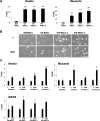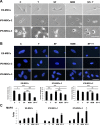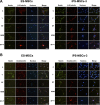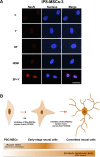Human pluripotent stem cell (PSC)-derived mesenchymal stem cells (MSCs) show potent neurogenic capacity which is enhanced with cytoskeletal rearrangement
- PMID: 27304057
- PMCID: PMC5190070
- DOI: 10.18632/oncotarget.9947
Human pluripotent stem cell (PSC)-derived mesenchymal stem cells (MSCs) show potent neurogenic capacity which is enhanced with cytoskeletal rearrangement
Abstract
Mesenchymal stem cells (MSCs) are paraxial mesodermal progenitors with potent immunomodulatory properties. Reports also indicate that MSCs can undergo neural-like differentiation, offering hope for use in neurodegenerative diseases. However, ex vivo expansion of these rare somatic stem cells for clinical use leads to cellular senescence. A newer source of MSCs derived from human pluripotent stem cells (PSC) can offer the 'best-of-both-worlds' scenario, abrogating the concern of teratoma formation while preserving PSC proliferative capacity. PSC-derived MSCs (PSC-MSCs) also represent MSCs at the earliest developmental stage, and we found that these MSCs harbor stronger neuro-differentiation capacity than post-natal MSCs. PSC-MSCs express higher levels of neural stem cell (NSC)-related genes and transcription factors than adult bone marrow MSCs at baseline, and rapidly differentiate into neural-like cells when cultured in either standard neurogenic differentiation medium (NDM) or when the cytoskeletal modulator RhoA kinase (ROCK) is inhibited. Interestingly, when NDM is combined with ROCK inhibition, PSC-MSCs undergo further commitment, acquiring characteristics of post-mitotic neurons including nuclear condensation, extensive dendritic growth, and neuron-restricted marker expression including NeuN, β-III-tubulin and Doublecortin. Our data demonstrates that PSC-MSCs have potent capacity to undergo neural differentiation and also implicate the important role of the cytoskeleton in neural lineage commitment.
Keywords: Rho A kinase (ROCK); human embryonic stem cells (ESCs); human pluripotent stem cells (PSC); induced pluripotent stem cells (iPS); mesenchymal stem cells (MSCs).
Conflict of interest statement
The authors declare no conflicts of interest.
Figures





Similar articles
-
Production of Mesenchymal Stem Cells Through Stem Cell Reprogramming.Int J Mol Sci. 2019 Apr 18;20(8):1922. doi: 10.3390/ijms20081922. Int J Mol Sci. 2019. PMID: 31003536 Free PMC article. Review.
-
Comparative analysis of neural differentiation potential in human mesenchymal stem cells derived from chorion and adult bone marrow.Cell Tissue Res. 2015 Nov;362(2):367-77. doi: 10.1007/s00441-015-2210-z. Epub 2015 May 30. Cell Tissue Res. 2015. PMID: 26022335
-
Pluripotent gene expression in mesenchymal stem cells from human umbilical cord Wharton's jelly and their differentiation potential to neural-like cells.J Med Assoc Thai. 2013 Sep;96(9):1208-17. J Med Assoc Thai. 2013. PMID: 24163998
-
Human periapical cyst-mesenchymal stem cells differentiate into neuronal cells.J Dent Res. 2015 Jun;94(6):843-52. doi: 10.1177/0022034515570316. Epub 2015 Feb 11. J Dent Res. 2015. PMID: 25672890
-
Muse Cells Provide the Pluripotency of Mesenchymal Stem Cells: Direct Contribution of Muse Cells to Tissue Regeneration.Cell Transplant. 2016;25(5):849-61. doi: 10.3727/096368916X690881. Epub 2016 Feb 15. Cell Transplant. 2016. PMID: 26884346 Review.
Cited by
-
Stromal Galectin-1 Promotes Colorectal Cancer Cancer-Initiating Cell Features and Disease Dissemination Through SOX9 and β-Catenin: Development of Niche-Based Biomarkers.Front Oncol. 2021 Sep 10;11:716055. doi: 10.3389/fonc.2021.716055. eCollection 2021. Front Oncol. 2021. PMID: 34568045 Free PMC article.
-
PSC-MSC-Derived Exosomes Protect against Kidney Fibrosis In Vivo and In Vitro through the SIRT6/β-Catenin Signaling Pathway.Int J Stem Cells. 2021 Aug 30;14(3):310-319. doi: 10.15283/ijsc20184. Int J Stem Cells. 2021. PMID: 34158415 Free PMC article.
-
Human ESC-derived Neuromesodermal Progenitors (NMPs) Successfully Differentiate into Mesenchymal Stem Cells (MSCs).Stem Cell Rev Rep. 2022 Jan;18(1):278-293. doi: 10.1007/s12015-021-10281-0. Epub 2021 Oct 20. Stem Cell Rev Rep. 2022. PMID: 34669151
-
Human iPSC banking: barriers and opportunities.J Biomed Sci. 2019 Oct 28;26(1):87. doi: 10.1186/s12929-019-0578-x. J Biomed Sci. 2019. PMID: 31660969 Free PMC article. Review.
-
Stem Cells Run Like Clockwork for Stroke Therapeutics.Stem Cell Rev Rep. 2025 Jul 18. doi: 10.1007/s12015-025-10895-8. Online ahead of print. Stem Cell Rev Rep. 2025. PMID: 40676475 No abstract available.
References
-
- Lindvall O, Kokaia Z, Martinez-Serrano A. Stem cell therapy for human neurodegenerative disorders-how to make it work. Nat Med. 2004;10:S42–50. - PubMed
-
- Reynolds BA, Rietze RL. Neural stem cells and neurospheres—re-evaluating the relationship. Nat Methods. 2005;2:333–336. - PubMed
-
- Sanchez-Ramos JR. Neural cells derived from adult bone marrow and umbilical cord blood. J Neurosci Res. 2002;69:880–893. - PubMed
-
- Pittenger MF, Mackay AM, Beck SC, Jaiswal RK, Douglas R, Mosca JD, Moorman MA, Simonetti DW, Craig S, Marshak DR. Multilineage potential of adult human mesenchymal stem cells. Science. 1999;284:143–147. - PubMed
-
- Yen BL, Huang HI, Chien CC, Jui HY, Ko BS, Yao M, Shun CT, Yen ML, Lee MC, Chen YC. Isolation of multipotent cells from human term placenta. Stem Cells. 2005;23:3–9. - PubMed
MeSH terms
Substances
LinkOut - more resources
Full Text Sources
Other Literature Sources

